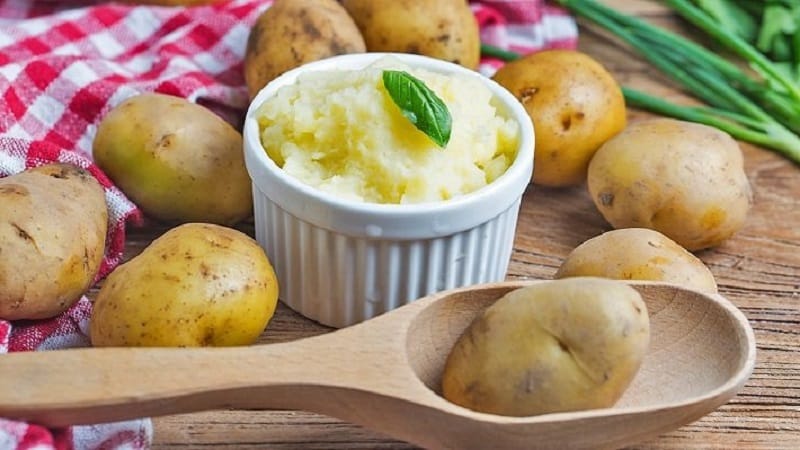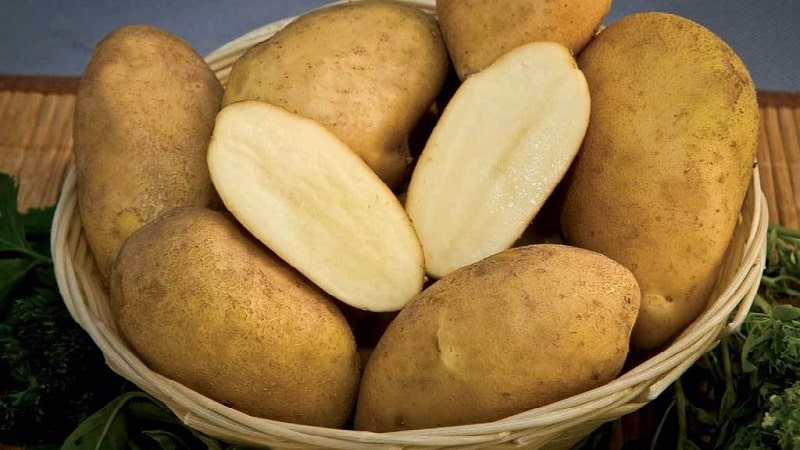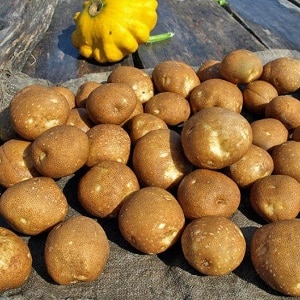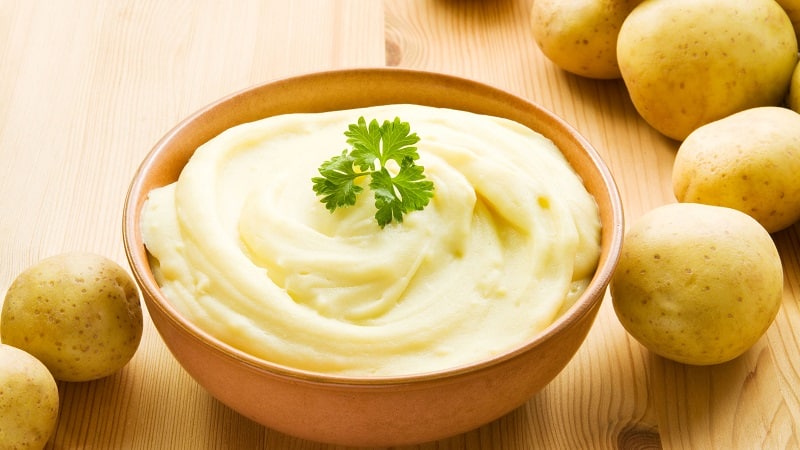The ideal potato variety for mashed potatoes
Mashed potatoes are one of the easiest and most nutritious foods to make. Its taste and appearance largely depend on what kind of potatoes are used for cooking. You need boiled tubers with a high starch content. What potato varieties and hybrids meet these requirements?
What type of potato is suitable for mashed potatoes?
All Potato varieties are divided into 4 groups based on how much the vegetable is boiled. Each group is assigned a letter of the Latin alphabet, which marks both varieties and seeds. In Russia, such a classification is not common, although someday it will appear in our country:
- A - potatoes of this group have dense flesh and are almost not boiled. Suitable for salads where vegetables are cut into small cubes.
- B - the flesh is dense, but not as much as in the first group. The potatoes are moderately boiled, suitable for salads and frying.
- C—the pulp is starchy, soft, and boils well.
- D - very starchy, mealy varieties that almost completely crumble when cooked.
Whether the potatoes will be boiled and suitable for mashing depends on starch content in tubers.

To check friability, cut the vegetable into 2 halves and rub them together. If they stick together, they are a Group C or D potato. If there are drops of water between the halves, they are a firm, non-starchy Type A or B, suitable for stir-fries and salads.
Attention! Typically, the most boiled varieties of potatoes for mashed potatoes have medium and late ripening periods.Early crops simply do not have time to accumulate enough starch.
The most crumbly varieties of potatoes for mashed potatoes
Potatoes with high starch content:
- Riviera. The tubers are medium size, oval in shape. The pulp is granular and creamy. The peel is thick, light beige. Starch content - 11.5–15.9%. The variety is early ripening, tolerates drought, but is susceptible to late blight. The yield is high: 134–225 c/ha during the first digging, 273–312 c/ha during the second.
- Bellarosa. The tubers are round and medium in size. The peel is reddish, the flesh is light yellow. The amount of starch is 12.6–15.7%. The variety is resistant to diseases, early ripening, high-yielding. During the first digging, 143–277 c/ha are collected, during the second – 170–385 c/ha.
- Tiras. An early variety with high yield - 210–460 c/ha. The tubers are pinkish in color and oblong in shape. The pulp is light yellow. Starch content - 10–15%. Potatoes have average resistance to late blight.
- Luck (pictured below). The tubers are light beige, rich in nutrients and vitamins. They contain 12–15% starch. The variety is early ripening, moderately susceptible to late blight. Marketable yield is 300–500 c/ha. Vegetables are stored for a long time.

Ideal potatoes for boiling
Which potatoes are best for frying and boiling? Russian and Belarusian varieties belonging to group C or D are quite boiled. Dutch and German varieties have dense tubers that are good for roasting and deep-frying.
By the way! One of the signs of starchy potatoes is white flesh and rough skin.
Fast-cooking potato varieties:
- Blue. The plants have white-blue flowers, hence the name of the variety. The crop is mid-season, high-yielding - 400–500 c/ha. Tubers of group C or D, they contain 17–19% starch.Vegetables are oval, light beige, with creamy flesh.
- Zhuravinka. Middle late culture. It is unpretentious in care, produces 177–242 c/ha of potatoes. The tubers are oval-round red, the flesh is light. The starch content is high - 14.6–19.6%.
 Kiwi (photo on the right). Potatoes have a rough surface, as if covered with a mesh. It takes a long time to ripen - up to 120 days. The variety is high-yielding and pest-resistant. The vegetables are light brown and round. The pulp is creamy. The starch content is high.
Kiwi (photo on the right). Potatoes have a rough surface, as if covered with a mesh. It takes a long time to ripen - up to 120 days. The variety is high-yielding and pest-resistant. The vegetables are light brown and round. The pulp is creamy. The starch content is high.- Elizabeth. Mid-early variety with high productivity - 290–400 c/ha. The tubers are white with smooth skin and light flesh. Starch content - 12–18.4%. Suitable for making purees.
- Aurora. The variety is mid-season, resistant to various climatic conditions. The skin of the tubers is reddish, oval in shape, and the flesh is creamy. Starch content is average - 13.5–17.3%. The taste is excellent.
Red or white potatoes for boiling
There are many hybrids and varieties of crops on sale with different color tubers - from beige and yellow to red and pink. According to the degree of starchiness, white and yellow potatoes are suitable for mashed potatoes..
Red is more suitable for frying: due to its low starch content, it sticks less to the pan. However, there are hybrids with red and pink tubers that boil well. Therefore, the main thing when choosing vegetables is the “stickiness” rule.

Culinary tricks
Preparing puree is not difficult, but there are some nuances here too.:
- Overcooked potatoes will only improve the taste of the dish. Hard tubers are difficult to mash into puree, and pieces remain in the finished dish.
- Pour a little water into the pan so that the potatoes steam more.
- In order for vegetables to cook better and faster, they are completely peeled and cut into large pieces.
- After cooking is completed, the water is poured into a separate container. Little by little liquid is added to the puree, making it softer.
- To create a delicious dish, take half the water in which the potatoes were boiled and half fresh milk.
- Do not add cold water to the product - this will cause the taste and attractive color to be lost. It is advisable to cook the tubers in enamel dishes - in aluminum and iron pans they turn grayish.
- Before adding water and milk to the mashed potatoes, salt the mashed potatoes. The liquid will dissolve the salt, and when stirred, it will be evenly distributed throughout the mass.
The final touch - add a little butter to the still hot puree to give a special taste.
Conclusion
Potatoes with a high starch content are suitable for mashing. Most often these are white or yellow varieties: Riviera, Tiras, Bellarosa, Zhuravinka, Aurora and others. The starchiness of a potato is determined by cutting it in half: if you rub the halves against each other, they will stick together in a boiled vegetable.
To make the puree especially tasty, boil the tubers in a small amount of water, use cooking water and milk when kneading, and add a piece of butter at the end.